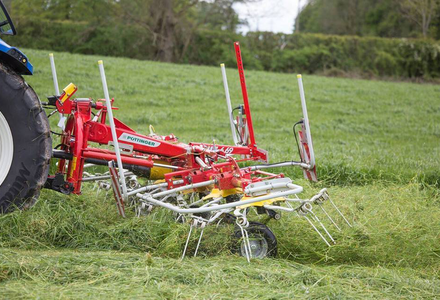Don't leave late-cut grass in the swath
28 September 2018
After this summer’s drought, late-cut grass will provide a much-needed boost to low silage stocks on many farms.
Usefully, grass growth has also been good of late – producing lush, thick swards of reasonable quality albeit with low Dry Matters.
Worryingly, however, from field observations, it appears not everyone is taking the appropriate steps to prepare grass crops properly for ensiling.
What are the risks?
If you don’t wilt these lush crops properly, not only do you risk increased silage effluent from their higher water content, but also a poorer fermentation.
This is because the high moisture levels in the grass will dilute the beneficial acid produced during the fermentation process, which is needed to ‘pickle’ the grass and preserve it. The result is the pH will take longer to fall, allowing undesirable microbes to ‘feed’ on the silage for longer – reducing tonnes of dry matter and quality.
To wilt properly, don’t leave grass in the swath after cutting. Instead, spread it straightaway. The wider you spread it, the faster it will wilt.
Spreading the grass is always important, but at this time of year there is no way that you can achieve a target dry matter of 30% without spreading the swath. Moving the grass will rapidly increase speed of wilt but be aware that if ground conditions are soft make sure the tedders and rakes are set up properly to avoid soil contamination. Left unspread in the swath it will not reach reasonable dry matter to give a good fermentation - It’s amazing how much it will dry if you spread it out.
Other ‘watch points’ with late-cut grass
As well as high moisture levels in grass posing a risk, another ‘watch point’ is the increased risk of soil contamination of grass due softer ground conditions during cutting and harvesting. This can introduce undesirable bacteria into the clamp.
At the same time, the number of any beneficial fermentation bacteria present on the grass is likely to be lower at this time of year, because of colder temperatures.
Plus, sugars (which are needed for fermentation) are likely to be in shorter supply, because of lower levels of photosynthesis due to less sunlight and shorter days.
Compelling case
All these factors provide an even more compelling case for using a proven bacterial additive to help later-cuts, so that you convert the limited sugars that are available into beneficial acid more efficiently – therefore killing off undesirable microbes before they take hold and have chance to deplete the quantity and quality of what’s in the clamp.
In grass silage trials, treating with Ecosyl has been shown to save dry matter by 3.7% over untreated silage. That’s equivalent to a having an extra 37 tonnes to feed from a 1,000 tonne clamp.
That is even before taking into account improvements in silage quality that treating with Ecosyl has delivered – such as improved protein preservation and improved digestibility.
No wonder, then, that Ecosyl-treated silage has also been shown to improve milk yield per cow day.
Download Ecosyl product brochure
Ready to start using Ecosyl? Head on over to our order form today.
